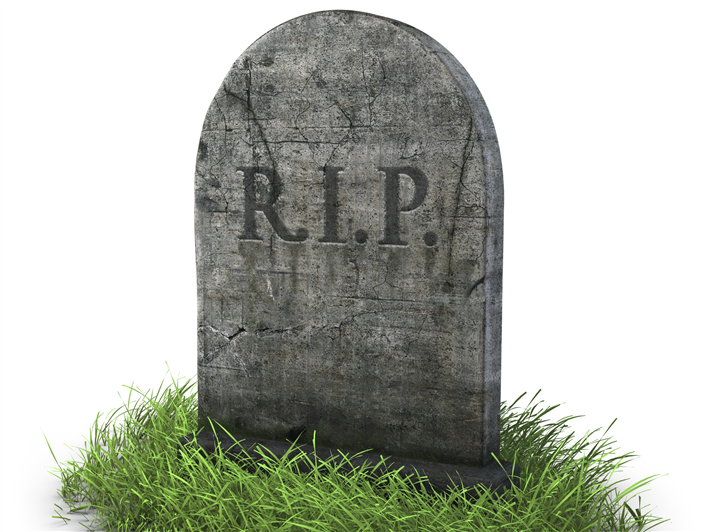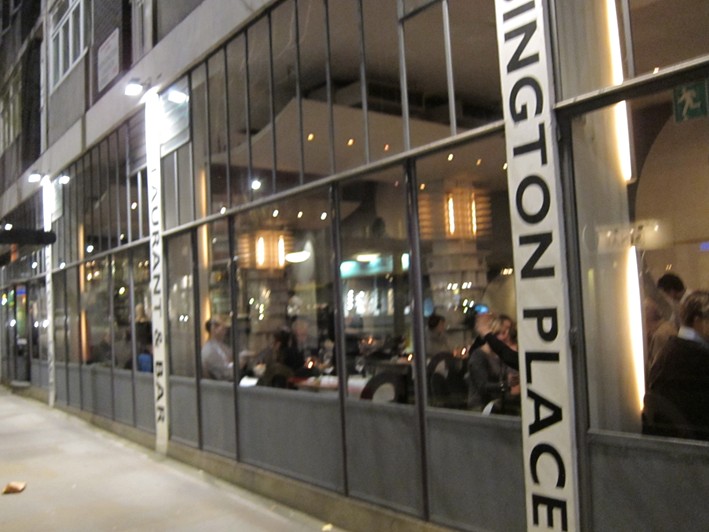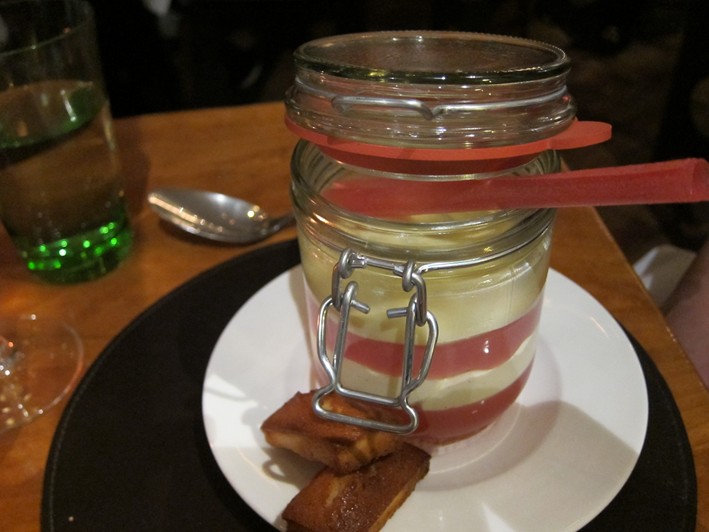Kensington Place is that rare thing, an iconic restaurant. With its striking, cavernous open space with picture windows, and dishes later regarded as classics like its scallops with pea puree, this was a pioneer amongst British cooking when it opened in 1987. After establishing this restaurant as a ground-breaking force in British cooking, Rowleigh Leigh (who trained at Le Gavroche) moved on from Kensington place in December 2006 to his own venture Le Café Anglaise. These were big boots to fill and recently these were taken by Henry Vigar, who worked under Bjorn van de Horst at the ill-fated Noisette. The head chef is now Daniel Phippard, formerly sous chef at Alimentum in Cambridge.
The dining room is still striking, more than two decades on, with its floor to ceiling picture windows, wooden floor and bright, enticing space. It was six years since my last visit, and our initial experience did not bode well. After being seated, it was if we had been placed in some sort of virtual black hole as regards the waiting staff. Waiters looked on, waiters passed by, and yet no menu appeared, no one offered us a drink, no one acknowledged our existence. After a couple of minutes this was mildly amusing, but as time moved in it became stranger and stranger, as if we had stumbled into an episode of The Twilight Zone. There weren’t that many staff, admittedly, but other tables had dishes brought, and I vainly, and increasingly despairingly, tried to get any form of attention. Eventually fifteen minutes had elapsed since we had sat down, and we were no closer to getting a menu. Feeling a little like Michael Winner, I then used my mobile phone to call the restaurant. I could see the red light on the main phone blinking yards away, and eventually the restaurant manager responded and picked up the receiver. At this point I asked if the table by the window could please see a menu. To his credit, after an understandably surprised pause, he duly arrived with a menu and wine list.
The wine list stretched to eight pages. Jean Marc Pilot Chassasgne Montarchet 2004 was listed at £84 compared to a shop price of around £29. The excellent Meerlust Pinot Noir 2006 was a quite heavily marked up £48.50 as against a retail price of around £15, while Valle Perdido Malbec 2007 was £25 for a wine you can buy for about £8 in the shops. The menu itself was a modest £25 for three courses, with vegetables a chunky £4.25 extra. Bread was a choice of sourdough or whole grain slices, prepared at “another restaurant in the D&D group” and adequate, not quite as fresh as would be ideal (12/20). I began with pheasant cannelione, resting on a bed of Puy lentils, with celeriac and chestnut crumb. This was very good, the pasta perhaps a little soft in texture, but the Puy lentils cooked well, and the pheasant tasty and decently seasoned (14/20); the portion size was on the modest side, as was the case with the soup. Smoked haddock chowder was flavoured with chives and thickened with cream, the haddock itself properly cooked, though in this case a little extra seasoning would have helped (13/20).
Sea bream was of good quality and carefully timed, served with excellent Charlotte potatoes, and a smear of enjoyable Bordelaise sauce, made from red wine, bone marrow and (according to the menu) truffle. This was a successful dish, the fish tasting good, the sauce having reasonably good flavour, the potatoes a pleasing texture, though the celeriac was a little unusual, being neither puree nor regular celeriac, but something in between (14/20). Truffled cauliflower risotto had acceptable texture and pleasant cauliflower flavour, the stock used being absorbed well enough into the rice. If there was truffle here it was exceedingly subtle, and again bolder seasoning would have improved the dish (13/20). Green beans on the side were a little undercooked but harmless enough (12/20).
Daniel’s background as a pastry chef came through with desserts. Rhubarb jelly and ice cream was served in a glass jar and conceptually was a fine dish, with Coteaux du Layon ice cream and, on the side, a pair of almond financiere. The rhubarb itself was good, though the financiere were a little dry, but the problem was with the ice cream, which had good taste but a grainy texture. Seemingly they use a Pacojet to make the ice cream, so the problem is not with the equipment; this dish was new on the menu, and hopefully will be tweaked as it has potential (13/20). Much better was rich chocolate marquise, served with mandarin sorbet and a few blobs of crème Anglaise (custard) – the texture and flavour of the marquise proving excellent (15/20). Coffee was a decent measure, if a fraction bitter. The bill came to £115.95 without service, and the service was, after the initial odd aberration, perfectly pleasant, and they were very nice about the problem at the beginning, which counts for a lot.
Overall this was an enjoyable meal, once they had remembered that we actually were in the restaurant. The cooking was at all times competent, with an attractive menu and touches of class. At £25 for three courses in the evening this is also a more than acceptable price given the area.
What follows are notes from a meal in 2004, by way of comparison.
An institution in the London restaurant scene, the busy, noisy dining room with the floor to ceiling windows has managed to keep its standards high over the years. Service, despite the bustle, is friendly and competent. Old favourite dishes continue to impress e.g. seared scallops with pea puree is a classic, the scallops fat and juicy, the odd-sounding puree a fine foil for the scallops. Seafood is handled well, but then so was some excellent corn-fed chicken on my last visit here. The lemon tart here is particularly good, and features excellent citrus bite to balance the sweetness of the filling. The wine list is attractive and acceptably priced. Overall Kensington Place is a place to be cherished.
See Cafe Anglais for Rowley Leigh's latest venture.




















Add a comment
Thank you for submitting your comment, this will be checked and added to the website very soon.
User comments